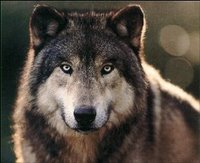Wolf facts

- Wolves are one of the common sacred spirit animals that act as guards. In Zuni mythology sacred animals guard the six cardnial directions. Mountain Lion to the north, Badger the south, Bear the west, and Wolf guards the east.
- There is not now, nor has there ever been any record of healthy wild wolves ever attacking or killing humans. Yet, people have killed about two million wolves since North America was settled by Europeans. Native Americans have always regarded wolves as teachers, not enemies. They revered the wolf an embodiment of their own cherished ideals.
- A wolf’s sense of smell is 100 times more sensitive than a human’s.
- Wolves can hear as far as 6 miles [9.6 kilometres] away in the forest and ten miles [16 kilometres] away on the open tundra.
- Wolves have been known to respond to human imitations of wolf howls from 4 kilometres away.
- Popular imagination has long held that they also howl at the moon, but there is no evidence that this is so. Wolves may be more active on moonlit nights, when they can see better, or we may hear them more often on such nights, because we feel more comfortable tramping about in the light of a full moon, but a wolf howling at the moon would be wasting its breath.
- Wolves are the largest members of the dog family. All domesticated dogs are descendents of the wolf.
- When wolves howl, they are greeting one another, guarding their territory or calling their pack together. Also they seem to like howling.
- Wolves can go up to 2 weeks without eating a meal.
- Wolves do bark, but very seldom, and when they do it it's really quiet. They do not bark repeatedly like most dogs.
- Small animals and birds are the common prey of wolves. They also occasionally eat berries.
- In the winter, the wolf's tail helps keep the face warm.
- Wolves can maintain a chase for at least twenty minutes.
- You can tell wolves are friendly ,when they roll over and show their bellies. When they want to play, they put their paws down and wag their tail. When they want to fight, they show their fangs and start growling. When they want to stop they put their ears back and lay down.
- In the highly social communities of wolves, a wolf alone is nothing admirable or desirable. A lone wolf by definition is an outcast for some reason -- illness, weakness, unsociability. Nothing personal, just the business of nature. He or she who is alone is an alien threat to any pack leader's dominance and the pack's food supply, breeding and pure bloodlines. Being alone and in a pack's private hunting territory makes hunting -- and survival -- infinitely harder.


2 Comments:
is it your own words? i think it is. from what u write, i know much more about wolves, and begin to like them.maybe we(except u) r confused by their cold and awful faces, under the faces, having their warm hearts. i believe wolves and human being lived in very kind and harmonious ways in the past. but now who care of their fate and other wild animals'?
i would like to see a wolf, while he eats berries... :)
Post a Comment
<< Home